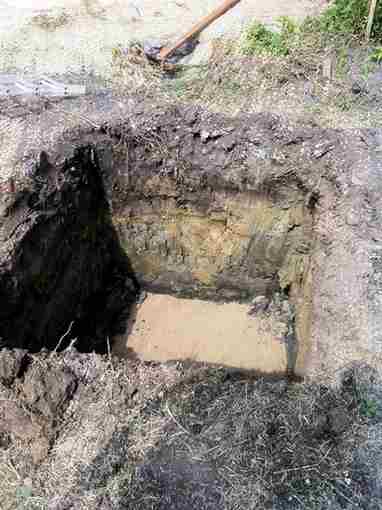Soakaway Tests
There are 3 test that are mandatory before you can have a soakaway. These form part of the Building Regulations and the BS 6257 2007
- Determine that you are not in a groundwater source protection zone. Contact us if you are not sure and we will find out for you.
- Dig a Trial Site Assessment Hole
- Conduct a series of Percolation Tests
Groundwater Source Protection Zones
These are areas that contain water under the ground that is used for public drinking water supplies. Obviously, you are not allowed to contaminate them with sewage bacteria, so you are not allowed to have a sewage soakaway if you are in one of these zones.
Trial Site Assessment Hole 
This is a hole that is dug to test the highest pont of the water table at any time of the year. It is a large hole, minimum 1M² and 2.1M deep. The groundwater must never rise into this depth. Unless you have 1 metre of dry soil below the soakaway at all times, it will not work and you will not be allowed to have a soakaway as you cannot soak away into already saturated soil. You can see in the photo on the right that this trial site assessment hole has failed as it is filling with groundwater.
Percolation Tests
These are a series of tests done to assess the porosity of the soil. Obviously, sandy soils are more porous than clay soils and the water will soak away faster in sandy soil than heavy clay. In fact, heavy soils usually fail the percolation tests altogether and you cannot have a soakaway at all.
How to carry out a percolation test
| A percolation test should not be carried out during abnormal weather conditions and if done in summer, then the times should be increased by 30% to 50%, depending on the recent weather. The percolation test method
Drainage field soak away disposal should only be used when percolation tests indicate average values of V of between 15 and 100 and the preliminary site assessment report and trial hole tests have been favourable. A percolation test is deemed to have failed if the results are less than 12 or more than 100. This minimum value ensures that untreated effluent cannot percolate too rapidly into ground water. Where V is outside these limits effective disposal is unlikely to take place in a soak away drainage field. * Some Councils insist that percolation tests are carried out by 'qualified persons' and do not accept your own test results. You may be required to contact a contractor to carry out the percolation test. Please check with your Local Authority. |
Calculating the size of the soak away
| The calculation gives the area (A), in square metres, required for the soak away trench. V = The time in seconds for the water in the test hole to drop by 1mm. p = The maximum number of persons that the unit is designed to serve. For sewage treatment units Area (A) = Vp X 0.20 For septic tanks Area (A) = Vp X 0.25 Further calculations are required to give the length of pipes required depending on the width of the trench, e.g. for a 600mm (2ft) wide trench, the area would be divided by 0.6. |

